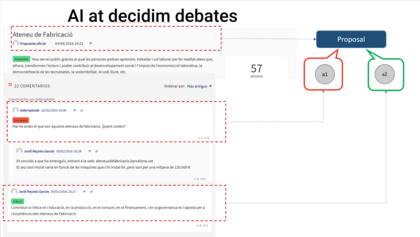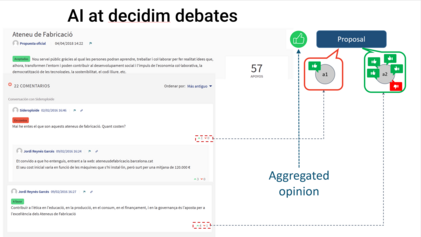Aggregate the opinions issued in a debate
The problem
Currently, debates allow participants to post comments/arguments in favour or against a proposal, and they can also express if they agree or disagree with the arguments issued by others. However, this information is not aggregated, and thus, it can be difficult to asses the debate results (that is, if the proposal should be accepted or rejected).
The solution
It would be really useful to aggregate all the opinions issued in a debate so that the result becomes apparent. The attached images illustrate this idea (thumbs up/down are just to illustrate the idea, proper design would be required).
This aggregated opinion would help to increase the quality of the debate (an thus, of the democratic process it represents), and may incentivise participants to pose their opinions.
Considered alternatives
The Barcelona City Council has funded several research projects for applying Artificial Intelligence techniques to solve this problem. Along these projects, several aggregation methods have been proposed but not yet added as functionalities to Decidim. These methods go beyond the simple idea of considering the proportion of comments in favour or comments against the proposal because, as shown in the attached images, some arguments may be stronger than others (that is, more people agree with them).
Additional context
These projects have provided the code for the aggregation computation as open source, but it needs to be translated to Rubi for it to be incorporated in Decidim.
We are researchers from the University of Barcelona and the Artificial Intelligence Research Institute (IIIA-CSIC), and are in touch with Platoniq to see how this new functionality could be incorporated into Decidim.
Does this issue could impact on users private data?
No, participants’ opinions are publicly shared.
Funded by
It could be partially funded through Fundació Solidaritat UB.
















Share
Or copy link